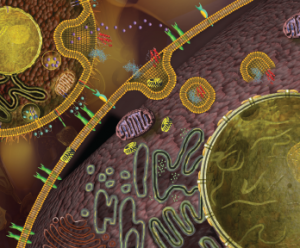
A genetically engineered T cell.
SAN DIEGO—At the 2017 ACR/ARHP Annual Meeting this past November, an expert said researchers are making progress in identifying drugs that can correct problems with transcriptional programming, which, if perfected, could go a long way toward harnessing more fully the power of genetics knowledge and directing it toward patient care. The session also delved into how researchers are working to apply a strategy similar to chimeric antigen receptor (CAR) T cell therapy to autoimmune disorders.
Controlling Transcription
Most of the genetic variants identified in genome-wide association studies (GWAS) map to noncoding DNA, and there’s a growing understanding that the vast majority of this noncoding DNA involves gene enhancers and repressors that can regulate transcriptional programs, said Dennis Carson, MD, professor of medicine at the University of California, San Diego.
“We do not yet have methods to identify drugs that can modify and, hopefully, correct aberrant transcriptional programs,” he said. “This is what we’re taking a stab at in our lab.”
Dr. Carson has pursued this line of research for a decade. The challenge, in part, is that what’s encoded are not proteins, and the enhancer or repressor effect depends on the cellular context, so organism-wide targeting could produce undesirable effects. Plus, multiple enhancers and repressors work together in complex ways to control the transcriptional programs.
Dr. Carson’s center has approached the problem with a high-throughput process to examine how drugs or compounds regulate the transcriptional response when a stimulus is applied.
“Our idea was you might be able to find improved approaches for the discovery of immune regulatory drugs by looking at drugs or compounds that regulate the magnitude of transcriptional response to a stimulus, the kinetics of a transcriptional response and breadth of a transcriptional response,” he said.
Using biochemical and computational methods, the researchers look for compounds that act either as an immune enhancer and slow the response to the stimulus, or as an immune repressor and speed it up—all without affecting the basic physiology of the response. They’ve looked at the NF-kappa-beta and interferon pathways.1
To pare down the compounds to legitimate contenders, the researchers first focused on those that feature kinetics similar to other compounds and might hit the same target, and that have similar chemical structures to others, making it much more statistically likely they’re true hits. Then researchers moved to RNA sequencing to further validate the compounds.
